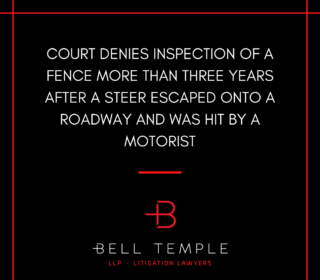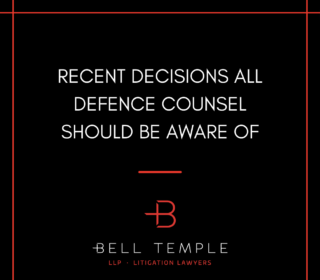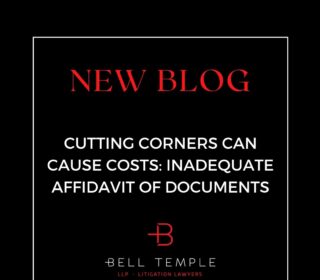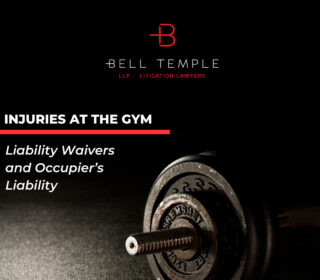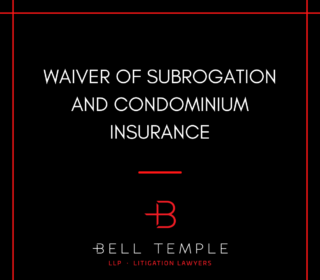The UMC provision and OPCF-44R endorsement are important components of automobile insurance policies in Ontario. They are designed to protect policyholders from the financial risks associated with accidents involving underinsured, unidentified, or uninsured motorists.
Ideally, claims brought against defendants fall directly within the limits of their third-party liability insurance but occasionally, they do not. In these instances, the injured party can turn to their own insurance policy or the responding policy of the vehicle they were in for compensation for their alleged damages. The circumstances in which an injured party can turn directly to their own insurance company for compensation are instances where the at-fault party’s limits are insufficient, either because their coverage is limited or they are uninsured, or the at-fault party is unidentifiable (e.g. a hit and run). Under these circumstances, there are two types of compensation available to the policyholder: uninsured or unidentified and underinsured coverage.
UNINSURED / UNIDENTIFIED
Uninsured or unidentified automobile coverage is available to an injured party where the other driver involved in the accident cannot be identified or is uninsured. It is designed to protect the policyholder so that they are not left financially burdened due to the actions of an uninsured driver or unidentified driver.
Uninsured or unidentified coverage is governed by section 265 of the Insurance Act and regulation 676 under the Insurance Act (the “Act”). Uninsured coverage is mandatory in Ontario and is available to a policyholder, driver of an insured vehicle or occupant of an insured vehicle involved in an accident with an uninsured or unidentified third party.
Pursuant to section 2 of Regulation 676, coverage is limited to the statutory minimum limits for automobile liability insurance in the jurisdiction where the accident occurs. In Ontario, this limit is $200,000, pursuant to section 251 of the Act. This limit is per occurrence, which means, regardless of the number of parties claiming uninsured or unidentified coverage, the limit does not change. The claimants share the $200,000 pro-rata.
UNDERINSURED COVERAGE
The other form of coverage, underinsured coverage, is accessible through the OPCF-44R endorsement (and/or form). Unlike uninsured or unidentified coverage, the OPCF-44R endorsement, is an optional endorsement that a policyholder may purchase to access additional coverage where the at-fault party is inadequately insured.
The OPCF-44R endorsement defines inadequately insured as:
“inadequately insured motorist” means:
(a) the identified owner or identified driver of an automobile for which the total motor vehicle liability insurance or bonds, cash deposits or other financial guarantees as required by law in lieu of insurance, obtained by the owner or driver is less than the limit of family protection coverage; or
(b) the driver or owner of an uninsured automobile or unidentified automobile as defined in Section 5, “Uninsured Automobile Coverage” of the Policy.
The OPCF-44R endorsement is designed to indemnify the policyholder for the shortfall of compensatory damages with respect to bodily injury to or death arising directly or indirectly from the use or operation of an automobile. It is not mandatory, and it is a governed by contract.
Indemnity under the OPCF-44 endorsement is also extended to the spouse of the policyholder, relatives in the same household, dependent relatives and relatives in the insured motor vehicle, a newly acquired automobile or a temporary substitute automobile.[1]
Often times, the liability limits under the OPCF-44R endorsement is $1M or $2M. Pursuant to the endorsement, if the claimant or policyholder’s injuries are caused by an inadequately insured motorist, the claimant may be able to recover the difference between the statutory minimum limits of $200,000 provided by the UMC policy and their OPCF-44R endorsement limits. That means, if the prayer for relief is $1M and the at-fault party is unidentified, there is $200,000 available under the UMC provision and the OPCF-44R insurer will respond to the remaining $800,000.
LIMITS TO COVERAGE UNDER UMC
As with all things, there are limits to the coverage available to policyholders and other eligible persons. Some of these limitations include instances where the insured vehicle is being operated by an excluded driver and the claimant was an occupant of that vehicle,[2] where a dependent relative suffers an injury while operating their own vehicle which was uninsured at the time,[3] or where the “uninsured vehicle” involved in the accident is owned by or registered in the name of the policyholder or their spouse.[4]
Interestingly, however, Uninsured Motorist Coverage cannot be denied in instances where the claimant was not authorized at law to drive. For example, in Matt v. Crawford,[5] the Court dismissed a summary judgment motion brought by the insurer seeking a dismissal of the action on the grounds that the plaintiff was not entitled to coverage by virtue of operating a vehicle while under the influence with a G2 license. The Court found that while there were sections of the Act which explicitly limited coverage to excluded drivers, no where in the Act or OAP-1 was there any indication that a claimant could not recover damages caused by an uninsured motorist, where the claimant itself was unauthorized to drive due to the OAP-1 provisions.
LIMITS TO COVERAGE UNDER OPCF-44R
Instances where the OPCF-44R endorsement would not be engaged, other than when the claimant is not an “eligible claimant” pursuant to the form, is where other available policy limits evenly match the limits of the underinsured coverage. For example, if the plaintiff claims $2M and the at-fault party has third party liability limits of $1M and the OPCF-44R endorsement is also limited to $1M, then the OPCF-44R endorsement would not be engaged. That is because the amount payable on the endorsement is only in excess to the amount received by the eligible claimant from any source.[6] In the alternative, if the plaintiff claims $2M and the at-fault party has third party limits of $1M and the OPCF-44R endorsement is limited to $2M, then the OPCF-44R endorsement would be engaged for the $1M in excess of the at-fault party’s limits.
This holds true regardless of the number of claimants. For example, if there are three dependent relatives in a vehicle who are injured and all have access to $1M pursuant to the OPCF-44R endorsement, and all claim $1M against a tortfeasor with $1M in liability limits, the OPCF-44R endorsement will not be triggered. This was the case in Van Bastelaar v. Bentley,[7] where the Court of Appeal held that the two claimants could not recover under their OPCF-44R endorsement despite four plaintiffs having to share in the at-fault party’s liability limits of $1M because the two policies were evenly matched.
Notably, however, there is no onus on the plaintiff to pursue all available policies of insurance for the OPCF-44R endorsement to be triggered. In Tuffnail v. Meeks,[8] the Court held that it was not necessary for an insured to pursue all possible tortfeasors before becoming entitled to access his own insurance. This was because of the change in the OPCF-44R form over the years. Specifically, the predecessor to the current OPCF-44R stated:
4 (a) the amount payable under this endorsement to any eligible claimant shall be ascertained by determining the amount of damages the eligible claimant is legally entitled to recover from the inadequately insured motorist and deducting form the amount the aggregate of the amounts referred to in paragraph 4(b), but in no event shall the Insurer be obliged to pay any amount in excess of the limit of coverage as determined under paragraph 3 of this endorsement.
(b)The amount payable under this endorsement to any eligible claimant is in excess to any amount actually recovered by the eligible claimant from any source (other than money payable on death under a policy of insurance) and is excess to any amounts the eligible claimant is entitled to recover (whether such entitlement is pursued or not) from:
…
(ii)the insurers of any person jointly liable with the inadequately insured motorist for the damages sustained by an insured person… [Emphasis added].
The reference to “whether such entitlement is pursued or not” was subsequently removed from the form and so the presiding Judge held that the change in the language was significant and signaled that it was no longer necessary for the insured to pursue all possible tortfeasors before becoming entitled to access his own insurance. This would not, however, prevent the insurer from issuing a third party claim seeking contribution and indemnity from the at-fault party.
Another limitation of the OPCF-44R endorsement is the coverage of legal fees and disbursements. In Hartley et al. v. Security National Insurance Company,[9] the Court of Appeal held that the plaintiff could not recover the U.S. legal fees incurred (as a result of an accident that occurred in the United States) against his OPCF-44R insurer in Ontario. The Court of Appeal relied on the clear terms of section 3 of the OPCF-44R, which states that indemnification is provided for the shortfall in “compensatory damages”. While legal fees are clearly incurred in securing compensatory damages, they are not themselves compensatory damages. The Court further referred to section 13 of the form, which states: “In determining any amounts an eligible claimant is entitled to recover from an inadequately insured motorist, no amount shall be included with respect to costs.”
The 1% Rule
Occasionally, the plaintiff may seek damages in excess of the at-fault party’s liability limits and may have access to additional OPCF-44R coverage but may be willing to release the insurer if there is an admission of 1% liability on behalf of the at-fault party. The rule of 1% liability applies only if there are other tortfeasors involved in the litigation based on the principle of joint and several liability set out in the Negligence Act.[10]
The admission of liability will depend on a variety of factors. If the defendant strongly believes that there is 0% liability on its part for the subject accident, then they may refuse to admit 1% liability. In this instance, however, if the plaintiff is fully at fault for the accident, then the OPCF-44R endorsement also would have no exposure.
Another instance where the defendant may refuse to admit liability is where the plaintiff refuses to limit the claim to the policy limits of the at-fault party. The plaintiff may be unwilling to do so because the damages are ongoing and may assess significantly higher than the at-fault party’s policy limits. In this case, the defendant (or the insurer of the defendant) would refuse to admit 1% liability, even if they are completely at fault, as it may prejudice their insured due to personal exposure. The defendant may also refuse to admit 1% liability if there is the potential of other claims that may erode the policy limits and again expose their insured personally.
PROTECTIONS AGAINST FRAUD
Understandably, there are significant risks for fraudulent claims where the claimant has been involved in a single motor vehicle collision and can access coverage by alleging the involvement of an unidentified party. As a result, there are a few protections against fraud where the claimant alleges the involvement of an unidentified motorist.
First, there are various notification requirements stipulated by Regulation 676 with respect to Uninsured or Unidentified Motorist Coverage in this regard. For example, where the claimant alleges that an accident occurred as a result of an unidentified vehicle, they are required, by section 3(1) of the Regulation to:
- Report the accident to a police officer, peace officer or judicial officer within 24 hours after it occurs or as soon as practicable after that time;
- To give the insurer a written statement within thirty days after the accident or as soon as practicable after that date, setting out the details of the accident;
- They must state whether the accident was caused by a person whose identity cannot be ascertained and whether the person insured under the contract was injured or killed and property was damaged in the accident; and lastly
- The person or their representative must make the vehicle which was involved in the collision, available to the insurer for inspection upon request.
The risks of fraud are even greater where the coverage limit is increased to $1M or $2M as with the OPCF-44R endorsement. Given the increased funding available, the OPCF-44R endorsement goes a few steps further in mitigating against fraud. The endorsement provides that any claims for damages caused by an unidentified motorist must be supported by corroborative evidence.[11] Section 1.5(D) defines corroborative evidence as evidence that is supported either by way of an independent witness (which cannot be the claimant’s spouse or dependent relative), or physical evidence such as tire tracks, paint tracks, etc.
While this is a higher standard of proof than what is required pursuant to the Act for unidentified or uninsured motorist coverage, Courts have held that coverage provisions are to be interpreted broadly and exclusions narrowly.[12] For example, in the Court of Appeal decision Pepe et al. v. State Farm Mutual Automobile Insurance Company (2011)[13] it was held that the claimant’s girlfriend, who had also issued her own claim against the UMC provider, constituted as an independent witness as the contract made no comment as to whether the witness can or cannot have a financial stake in the outcome of the issue. The Court of Appeal also held that the “girlfriend” did not fall within the exclusion of the spouse or dependent relative as described in the contract.
Most recently, in Aditi v. Doe,[14] the Court held that hearsay evidence contained in police notes from a witness who could no longer be located was sufficient in meeting the corroborative evidence requirement under the OPCF-44R endorsement, even though the evidence could not be verified and there were some concerns as to the truth of its contents. It was ultimately held that the OPCF-44R endorsement was engaged.
On the other side of the spectrum, in Chmieleswki v. Pischak[15], the Court granted the insurer’s summary judgment motion dismissing the action as the only corroborating evidence provided by the plaintiff was front-end damage to her vehicle. She relied on the front-end damage to suggest that an unidentified vehicle suddenly cut through her lane, obstructing her view of the vehicle ahead and resulting in her rear-ending another (but identified) vehicle.
CONCLUSION
Understanding
and addressing the implications of the OPCF-44R endorsement and UMC provisions
can help insurers effectively manage the risks and obligations associated with this
type of coverage. Adhering to best practices can help streamline issues that will
eventually be the subject of litigation and possibly avoid litigation
altogether.
[1] OPCF44R: Family Protection Coverage, section 1.2(a)-(d).
[2] Insurance Act, section 265(3).
[3] Insurance Act, section 265(4).
[4] Insurance Act, section 265(2).
[5] [2010] O.J. No. 3622 (ONSC).
[6] OPCF44R: Family Protection Coverage, section 4.
[7] [2011] O.J. No. 4666.
[8] [2017] O.J. No. 4848
[9] 2017 ONCA 715
[10] R.S.O. 1990, c. N.1, section 1.
[11] Section 1.5(c)) of the OPCF-44R endorsement.
[12] Matt v. Crawford, [2010] O.J. No. 3622 (ONSC) at para 11.
[13] [2011] O.J. No. 2011.
[14] [2023] I.L.R. para. I-6366.
[15] [2014] O.J. No. 863 (SCJ).

